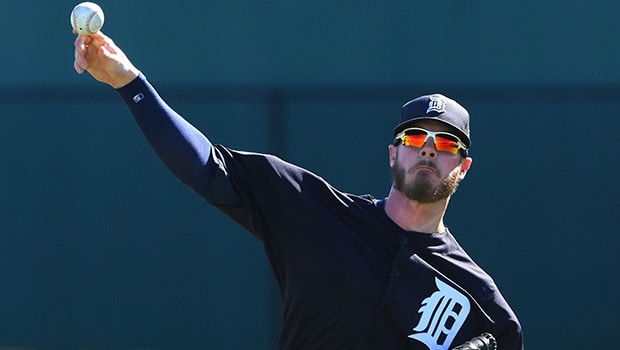The Tigers’ New Pitcher with Type 1

The bullpen is an intriguing place to watch a team’s pitching staff prepare and do nothing at the same time. Pitchers will trade stories, indulge in sunflower seed-throwing contests, and stretch, all to be ready when the call comes late in the game.
One pitcher recently signed by the Detroit Tigers will be doing something else – checking his blood sugar levels. Right-handed relief pitcher Mark Lowe, who has Type 1 diabetes, says he doesn’t feel prepared unless he micromanages his blood sugar to be at peak performance level when he enters a game. As a reliever, he may be called on to throw less than a dozen in-game pitches for the night, so there’s little room to be off.
“I’m obsessive about checking my blood sugar from the 3rd inning until the 7th inning,” Lowe said in a telephone interview. “I never like to be below 120 [mg/dL] when I’m throwing. When I’m done, I’m usually at 80 or 75.”
It’s this kind of fine-tuning that has allowed Lowe to find success in the big leagues for just under a decade, despite an early injury history and a late-in-life Type 1 diagnosis. The 2015 season provides a perfect example of how he has worked hard for success, which is never guaranteed in the big leagues. Although he started the season in the minor leagues, he stayed focused and was soon promoted to the big leagues with the Seattle Mariners. He then enjoyed one of the best seasons of his 10-year big league career, and was traded to the Toronto Blue Jays in time to pitch in for that team’s playoff run. At age 32, Lowe knows his career won’t go on forever, and he dedicates himself to staying healthy and on the field.
“You sit back and you get to see the door closing, and you want to do what you can to keep the door from closing,” he said.
In recent years, that has included switching to a near-Paleo diet, eating mostly fish, meat, and vegetables and avoiding grains and dairy. He credits this diet with helping him avoid the injury bug since 2012*.
“Paleo is a moneymaker for diabetics. It’s perfect,” he said of the low-carb diet. “Everything about it, it just makes sense.”
He also switched his workout routines in recent years, and discussed with his doctor about beginning to use a continuous glucose monitor. However, he says that a pump is not in the cards for him, as he believes it would be difficult to keep safe and intact during his work day.
“The pump is hard because we’re constantly goofing around,” Lowe said.
Adjustment has been the guiding principle for Lowe’s career, especially ever since he began feeling weak going into the 2008 season. Despite setting a goal to gain weight at the start of the season, Lowe couldn’t keep from shedding pounds. Blood work during spring training found he had elevated blood glucose levels. He says that trainers for the team he was with (again the Seattle Mariners) treated it initially like it was Type 2 diabetes and told him to avoid carbs.
“I don’t think there was enough knowledge within the organization about what to do,” he said.
Eventually, he put his foot down and elected for starting insulin therapy, and he felt much better. In the early days after his diabetes diagnosis, Lowe was fortunate enough to have the guidance of teammate Brandon Morrow, another pitcher with Type 1. He soon learned the ins and outs of blood glucose control, and integrated it into his life with diabetes.
That includes being open and not too serious about his diabetes around his teammates. He lets others in the clubhouse know that it’s a fair subject for jokes. He will even use it as a way to laugh off a momentary lapse in performance, which is a vital mental tool for a pitcher who makes his living in a game of millimeters each night.
“I use it as a scapegoat in the clubhouse,” he joked.
Lowe also has had to adjust to being a part of many different teams and living in many different cities. The Detroit Tigers will be his sixth major-league team, and he’s been with the Seattle Mariners twice. Since entering the big leagues in 2006, he’s also had stints with nine different minor league teams. At each stop, he’s the one in charge of his diabetes care, as he says trainers usually don’t have enough knowledge to help; other times he’s not with a team long enough to establish a medical relationship with a trainer. That was the case with his last team, the Blue Jays.
“I don’t even know if they knew that I had it,” he said.
Lowe says his teammates have been very supportive of him throughout his career. And while he says he’s very independent about his diabetes self-care, he says his wife has been indispensable in giving him the space to take care of himself.
Throughout the interview, it’s impossible to detect self-pity in the way Lowe talks about his diabetes. He says he feels grateful for all the treatment options available to people with Type 1. He also believes that his diagnosis helped him focus on what he needs to do to be healthy and happy, both on the field and off.
“It’s kind of a blessing in disguise,” he said.
*Insulin Nation does not endorse one diet over another.
Thanks for reading this Insulin Nation article. Want more Type 1 news? Subscribe here.
Have Type 2 diabetes or know someone who does? Try Type2Nation.